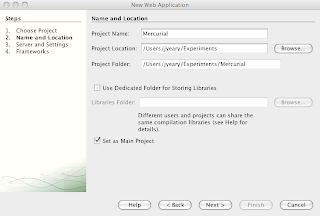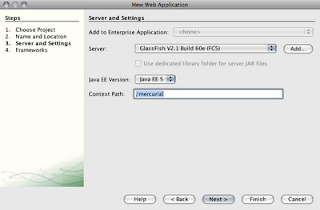Disclaimer: Adam Myatt and I have been on the JavaOne 2008 and 2009 Tools and Languages Review Committee. I don't believe that there is any predjudice for/against the book, but in the interest of disclosure I thought it important to mention. Don't you wish politicians had that much honesty?
I had the pleasure of reading the Pro NetBeans IDE 6 Rich Client Platform Edition book by Adam Myatt. I had read it a while ago, but I did not have the time to do a review on it. The book is sixteen chapters long, and covers a variety of topics from download and installation to developing rich client applications. The book covers version 6/6.1 of NetBeans, but there is significant applicability to version 6.5 to make it worth purchasing.
The book has a primary target of new users to the NetBeans IDE. It is designed to take you from novice user to power user in a systematic organized way. The book is sufficiently modular that you can choose to read individual modules, or go from cover to cover. The chapters stand on their own so that you do not need to worry about missing something in a previous chapter if you decide to browse.
Based on the easy reading style and effectiveness of communicating complex topics, I would give the book (4/5) stars.Chapter 1:Downloading, Installing, and Customizing NetBeans
This chapter covers the basics of installation, and explains a number of options available for configuration.
Chapter 2:The Source EditorHere we cover the basics of the source code editor and its windows. It also covers some interesting features of the source editor like the error stripe and annotation glyphs. The error stripe allows the user to go directly to any errors which are in the code. The annotation glyph provides the user with suggestions. These may be as simple as reminding you to mark @Override on an overridden method.
One of the best discussions in the chapter has to do with built-in and custom macros you can create to simplify coding tasks. This was a great explanation of how it works.
Chapter 3: Code Completion and TemplatesCode completion is what makes an IDE so valuable. This chapter covers the NetBeans code completion technology in detail.
It also covers code templates which are a boon to any developer who learns to use them. Adam really explains this in a manner that makes them easy to learn and use.
Chapter 4:DebuggingI thought I was fairly sophisticated in my use of debugging. This chapter made me feel inadequate. After reading it and implementing some of the ideas, I feel I am back to being an expert.
Note: I found one error on page 95. The third paragraph has Run --> Run File -->Run Debug Evaluate Expression. It should be Run --> Run File --> Run to Cursor.
I would buy the book for this chapter alone.Chapter 5:ProfilingThis chapter covers profiling for performance. Sun and NetBeans has spent a lot of time creating this technology (like DTrace), instrumenting, and providing tools. It is a shame that they really have not promoted these capabilities to the developer community.
Adam has spent a lot of time detailing profiling and providing great examples to get you into it. His explanations may be enough to encourage developers to use these really great tools.
This chapter also includes how to profile remote JVMs and application servers. It is a really slick explanation and demo.
Chapter 6:Managing Version ControlThis chapter covers version control system implementations in NetBeans. It covers CVS and Subversion. Since the book was written, the Subversion implementaion has had numerous improvements. NetBeans 6.1 and 6.5 also include support for Mercurial.
Chapter 7: Generating and Accessing JavadocThis chapter covers Javadocs and tools in the IDE to make Javadocs easier to create. I must admit I thought they were already easy, but there are some features to make it even easier including code completion.
Chapter 8:Managing Builds with Ant and MavenThis covers Apache Ant and Maven implementations in NetBeans. Adam covers some of the features of Ant with a high degree of skill. He covers the NetBeans implementation very well.
The section on Maven is a weak spot in the book. In fairness, the version of NetBeans which the book was based on had poor Maven capabilites. Version 6.5 of NetBeans has much better tools for handling Maven.
Chapter 9:JUnit TestingThis chapter covers JUnit testing. This is another chapter that is a little to weak. NetBeans 6.0, 6.1, and 6.5 have some really great implementations for doing JUnit testing. This chapter does not do it justice.
Chapter 10:RefactoringThis chapter covers refactoring. NetBeans has some really great refactoring tools.
JetBrains IntelliJ IDEA is the gold standard for refactoring, but each generation of NetBeans brings it one step closer.
There are some comprehensive explanations of how to use the refactoring tools in NetBeans. If you want to master the IDE, this chapter, and chapters 4, and 11 are a must.
Chapter 11:Code Quality ToolsThis chapter covers some of the really great plugins that are available for NetBeans including: Checkstyle, PMD, and SQE (FindBugs). If you are not using these static analysis tools in your code, you are doing yourself and customers a disservice. This chapter covers the tools in enough detail to get your interest. These plugins are in constant development, and you should check the latest versions and updates out.
These tools will make your code much better. You as a developer need to understand why. When Checkstyle marks code as a "Magic Number", you need to read the explanation. Understanding the why will help you to avoid these problems in your future code.
Chapter 12:Developing JRuby/Ruby on Rails ApplicationsThis chapter covers developing JRuby, and Ruby-on-Rails (RoR) applications using NetBeans. The chapter is not designed to teach you to program in Ruby, but to show you what features are available in the IDE. The NetBeans support for Ruby is fantastic. A number of other IDE developers are trying to emulate the functionality. I think that most Ruby developers will find that the support is a quantum leap in terms of ease and functionality over more traditional tools.
There is a note on page 297 which explains a really neat feature. If an existing application is deployed using Webrick, or Mongrel on port 3000, the IDE will increment the port number to prevent port in use errors.
Chapter 13:Developing Web ApplicationsThis is a long chapter covering web application development. The first part of the chapter covers the functionality of the IDE in terms of what features it provides. This includes items like the Javascript and CSS editors. Both of these tools are really useful.
The Javascript editor and debugger have been vastly improved in NetBeans 6.5.
The CSS editor with a change viewer make designing, or changing a CSS file a snap.
The chapter also covers the application server features and HTTP monitor. Specifically it covers Apache Tomcat and GlassFish. It explains how to add additional servers like JBoss, or Websphere to allow those server deployments.
The second half of the chapter covers web application development frameworks. The section covers Struts, Struts 2, Visual Java Server Faces (JSF) (Project Woodstock), and JMaki.
The Struts and Struts 2 section is relatively small. It provides the user with the basics of how to create and use Struts based projects.
The section on Visual JSF development is extensive and makes the book worth purchasing. The explanation on how to get started will set you on the right path. The section on visual data binding is elegant and simple. It also covers the Visual Database Query Editor. This functionality has been updated in NetBeans 6.5, but the explanation here still applies.
Note: Visual JavaServerFaces (JSF) development in NetBeans has been frozen. The promise of Project Woodstock in a version 4.3 release and beyond has been abandoned officially by Sun. The current supported version is 4.2. It will continued to be supported by the NetBeans team for the foreseeable future. The push by Sun is to provide support using third party providers of JSF components. The best of these providers is
ICEFaces. They have a really great set of components, and have provided a transition plan for Project Woodstock developers.
The section on JMaki is too brief to really provide a great explanation of this great technology.
Chapter 14:Developing Web Services: JAX-WS, SOA, BPEL, and RESTfulThis chapter covers JAX-WS, SOA, BPEL, and RESTful services. These projects have undergone extensive updates which makes the information here slightly dated. The basic procedures are the same, but there are better tools in NetBeans 6.5.
Chapter 15:Developing GUI ApplicationsThis chapter covers GUI application development. It is the best aggregation on the subject I have seen. There are a number of tutorials on the NetBeans site, and some good explanations of the features, but this is the best explanation I have seen. There is a great tutorial example of how to use the various components of the IDE to do visual Swing development. I was impressed and learned some new things too.
There is a section on the Swing Application Framework (JSR-296) which is the best I have seen. This technology is supposed to make Swing development easier. I used the information in here to create an enterprise wide application in 1/4 of the time it normally takes. It was also less error prone since the framework handles threading and concurrency issues.
Note: On page 427 there is a code example that has the user add a showHelloWorld method. There is a missing variable that needs to be added. It should have:
private JDialog helloWorldBox;
There is another section on Beans Binding (JSR-296) which covers another ease of use technology for Swing. It allows the developer to bind data components to Swing components in an easy and consistent way. The explanation here of the technology combined with JSR-295 makes Swing development easy. It also covers the Database Table Editor to make modifying tables easy to use as part of the binding process.
Note: Page 431, last paragraph indicates that you can use the DOUGHNUTS table node to use the table editor, this is not correct. You must open the table, and select a column to open the table editor.
Note: Page 442, to use the validator you have created, you must compile the code first. Either by selecting the class itself and compiling it, or clean and building your project.
I personally found that the GUI project development section was crucial to me for using these great new technologies, and development of a successful enterprise Swing application.
Chapter 16:Developing Rich Client ApplicationsThis chapter covers the development of Rich Client Platform applications using the NetBeans platform as the base for your application. This section provides an introduction to the technology, and the basics of how to create your own branded rich client applications.
Summary:I would recommend this book to anyone who wants to learn more about the NetBeans IDE.
Based on the easy reading style and effectiveness of communicating complex topics, I would give the book (4/5) stars.























